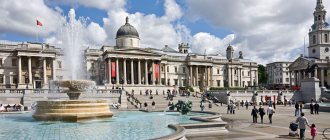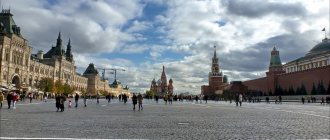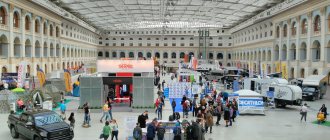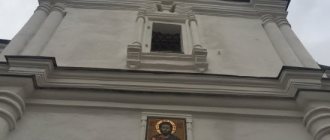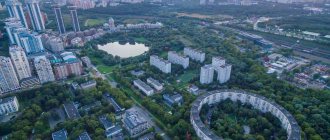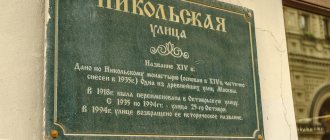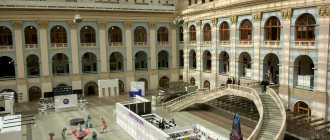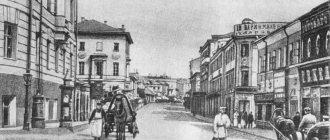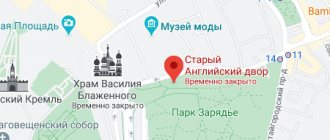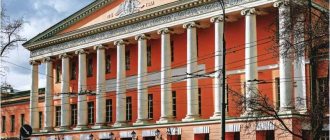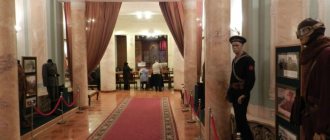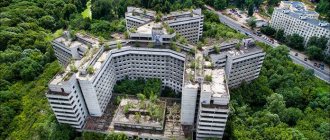Printing Yard on Nikolskaya Street is the place where the first dated book, the first newspaper, and the first Soviet money were created. Its architectural appearance is a real historical puzzle, because some of the most ancient cellars in Moscow, interesting buildings of the 16th–19th centuries have been preserved here, and from here you can also go to the Kitai-Gorod wall. Recently, the Historical and Archival Institute of the Russian State University for the Humanities, which occupies these premises, began conducting excursions around its territory. For the first time in many years, the most interesting details of the complex can be seen and literally touched. That’s what the m24.ru correspondent did.
Photo: m24.ru/Igor Ivanko
Studying the façade: rare eagles and crowned lions
Perhaps anyone who walks past the Printing Yard slows down and takes a closer look at the ornaments and figures on the light green background. “Why was it built in such an unusual style? Why do we need a sundial in our not particularly sunny climate? Why is there a lion and a unicorn on the façade?” - frequent questions that passers-by try to answer. We, excursionists, are lucky - in a couple of minutes, guide Nikita Brusilovsky will tell you everything.
It was at the Printing House that the first dated book, “The Apostle,” was printed on March 1, 1564. Ivan Fedorov, deacon of the Kremlin Church of St. Nicholas Gostunsky, managed to convince him to create a printing house near the Kremlin and publish liturgical books. True, he and his colleague Pyotr Mstislavets soon had to leave the city. There is a version that they were threatened by census takers, because with the advent of the innovative method they lost their jobs. However, it was no longer possible to stop the process - first liturgical and then secular books continue to be printed on Nikolskaya.
Photo: m24.ru/Igor Ivanko
“The printing house burned down and was rebuilt many times, and the author of the Spasskaya Tower, Christopher Galloway, participated in its creation,” says Brusilovsky. – The building received its current appearance in 1814–1815. Architect Ivan Mironovsky tried to partially repeat the appearance of the previous building of the Printing Yard, which by the beginning of the 19th century had fallen into disrepair and was dismantled in 1810. Some details were copied, for example the lion and unicorn - symbols of state power and wisdom. The lion was originally depicted with a crown, but it was knocked down in the 20th century. And the architects chose the pseudo-Gothic style because Gothic was then considered a sign of antiquity. Sundials are a tribute to fashion; at the beginning of the 19th century, some buildings were decorated in this way. You can see similar ones on the Moscow State University building on Mokhovaya. In addition, there was also a sundial previously on the old building of the Printing House.”
To find out all the nuances of the facade, you need to look at old photos, because some details are no longer there. For example, a double-headed eagle. According to the guide, he was unusual here - instead of a scepter and orb, he held olive and palm branches, symbols of enlightenment, in his paws. The double-headed eagle was surrounded by open books in radiance, a chalice (communion cup), a miter and other details. And if you carefully examine the coat of arms of the USSR that replaced the eagle, you can calculate in what years it appeared on the building.
Printing House and Correction Chambers
The most unusual building not only on Nikolskaya, but probably in all of Moscow is the Synodal Printing House complex. This is the birthplace of book printing in Russia. Ivan the Terrible and Metropolitan Macarius set up a Sovereign printing house on Nikolskaya. Most likely, books were printed here back in the 1550s. The first indisputable author of the dated book was Ivan Fedorov, a deacon of the Kremlin Church of St. Nicholas Gostunsky, who worked here together with Pyotr Mstislavets. They went down in history as the first Russian printers. The first dated book, The Apostle, was published on March 1, 1564, 120 years after Gutenberg.
The entire complex of these buildings combines architecture from different times. The basement of the buildings in the courtyard no. 15 dates back to the 16th century, when the Printing House was founded; the main part of the Book Preservation and Correctional Chambers of the Printing House that have survived to this day were built in the 17th century. (circa 1670s). As can be seen from the names, already printed books were stored in the first chamber, and in the second they were corrected (i.e., they were engaged in the work of a proofreader). For a long time, the magnificent building of the 17th century Printing House overlooked Nikolskaya. Unfortunately, over time it became very dilapidated, in 1775 the famous hipped tower was dismantled, and shortly before Napoleon’s invasion, the entire building of the Pechtany Dvor, which faced the street, was dismantled (in its place in 1814, the architect I.L. Mironovsky built a new building in pseudo-Gothic style, which, however, retained some features of the previous building - its three-part division, a sundial above both entrances, a Lion and a Unicorn above the gate, turrets, etc.). But the rest of the buildings, including the Book Depository and the Court of Justice of the 16th century. (as well as several side buildings dating from Elizabethan times) have been preserved.
The oldest building of the complex – the Correct Chamber, Teremok – is located in the courtyard. Famous archaeologist A.G. Wexler established that the underground floor of this chamber dates back to the end of the 15th century, that is, it is based on the oldest civil structure in Moscow.
In the 1870s a serious restoration of the chambers of the Printing House was carried out, with the restoration of their lost details and features (by that time they had lost something of their ancient appearance - some windows were cracked, the porch was dismantled, etc.). The restoration project was prepared by D.N. Chichagov, then N.A.’s project was added to it. Artleben (the latter did most of the work), the final plan was approved in 1872. According to descriptions in the receipt and expenditure books of the Printing House of the 1679 and 1680s. the appearance of the lost parts was restored. The porch with a tent was completely rebuilt. The surviving parts of the mural were uncovered and restored, and the lost pieces were restored according to descriptions (where possible). Based on the model of these murals, the painting in the chambers of Averky Kirillov was later restored. Then several more times additional research and finishing touches were carried out on the restoration.
After the revolution there was Goznak, then archives and the Central Archival Administration. In the 1930s, the Historical and Archival Institute was created, and since 1991, the Russian State University for the Humanities.
Time machine in the Yard
Inside the pseudo-Gothic building, the time layers are even more intertwined: according to Nikita, just walking along the corridor, we pass parts of buildings from the 17th to the 19th centuries. There is also a more ancient detail - pithos. This is an ancient Greek jug that resembles a huge amphora. Students of the Russian State University for the Humanities brought it from an archaeological expedition. There is a local joke that negligent students are put in pithos for re-education.
Photo: m24.ru/Igor Ivanko
In the courtyard of the Synodal Printing House (another Peter’s name for the place) there is its own “time machine”. Here are the buildings of the Legal and Book Preservation Chambers. In the first, craftsmen worked, whom today we would call proofreaders, and in the second, finished books were stored. The main part of the complex was built in the 17th century, but archaeologist Alexander Veksler dated the underground parts of one of the buildings to the end of the 15th century. That is, this is one of the most ancient civil buildings in Moscow. At the Historical and Archival Institute they call it “teremok”. He has a difficult fate in all respects. First, during the restoration of 1872–1875, a new porch was built. Previously, it overlooked the courtyard, but now it is adjacent to the wall. This made the yard wider, but some of the building’s windows now look non-functional. But this is only a small part of the adventures of the “teremka”...
Photo: m24.ru/Igor Ivanko
We go inside and find ourselves in the basements. As expected, it’s dark, cold, a little dusty, and there are some interesting things to see. In this case, the miraculously preserved historical columns of the old Printing House of the 17th century. During the Soviet era, they were exhibited in the institute museum, and in the 1990s they found themselves abandoned in one of the dark corners. Fortunately, several years ago they were found and cleared of debris.
In one of the rooms you can see the foot of the Kitai-Gorod wall. We pass another room - and we are in a room of the 20th century. The guide says that there was a gym here, and until recently there was even a basketball hoop, but it’s hard to believe.
Photo: m24.ru/Igor Ivanko
